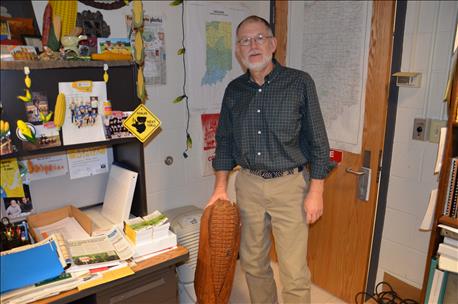
One of my earliest memories of Bob Nielsen is hearing him speak at a planter clinic. It was in the early to mid-1980s, and I was a wet-behind-the-ears field editor. Someone said I should go to this planter clinic at a John Deere dealership in Fowler. That’s Benton County, two hours from me. But my job was to travel the state, so I went. I settled into a metal folding chair with real-life farmers all around me.

DATA DRIVEN: The quest for data to prove what works and what doesn’t drives Bob Nielsen. But he also takes time to enjoy the finer things in life, including his favorite ear of corn carved out of wood.
My experience with planters was changing plates in Deere 494A and 694-A planters. It was a big deal when we went from metal to plastic planter plates. I had been around the new-fangled finger-pick-up planters, but I hadn’t actually used one. Everybody said they were the ‘cat’s meow’ for getting good stands.
Then in walks Nielsen. He starts telling farmers about how poor the spacing is in many fields he has walked. What is he doing, just trying to help them sell parts?
Maybe that’s why they invited him, who knows? But that wasn’t his intent. His message was that farmers really weren’t getting the picket-fence stands they thought they were. Planters were no longer adjusted correctly or working as they were designed in many cases. He backed up his words with research - a Bob Nielsen hallmark- always look to the data! He was showing significant yield gains for spacing plants correctly.
I was so impressed I actually went to farmer’s fields that summer and did spacing checks, crawling on my hands and knees with a ruler, recording the distance between plants. Of course, I asked the farmers first. I reported what I found. Nielsen was right- stands weren’t as perfect as most people thought.
That was 30 years ago. Today planters are much better, people are aware and stands in general are more uniform. But Nielsen is pursuing other issues, including helping farmers fine-tune nitrogen rates. And he always does it the same way - demanding data to back up his points.
So what does he have in his office? Computers? Yes, he has a computer. Books? Yes, he has books. Any researcher still has books. But what are those weird looking things in the corners of his office?
“These are my wood carvings that represent ears of corn,” he says. As it turns out, someone brought him one from a wood carving demonstration at the Indiana State Fair. He picked up the other one from the folks in Jay County. And he even has a third one at home.
“This one is my favorite because it is more realistic,” he says, standing next to the dark-stained ear of corn carved out of wood.
Why wouldn’t he like the one that is more realistic? He’s a scientist, after all!
About the Author(s)
You May Also Like




